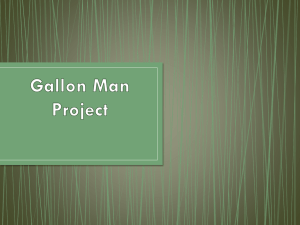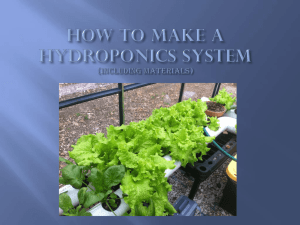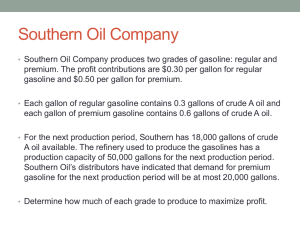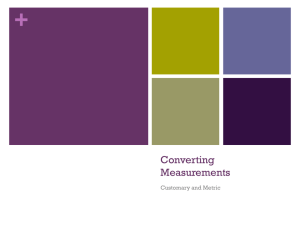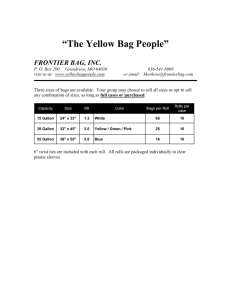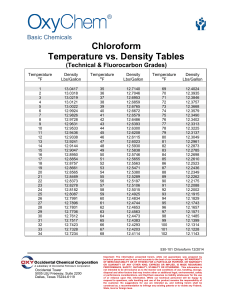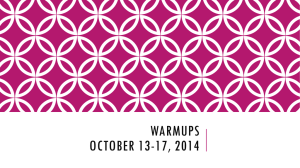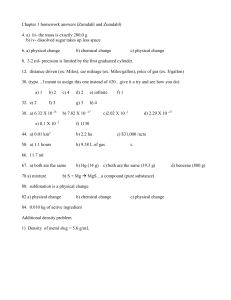Math_lesson_1_2_and_3
advertisement
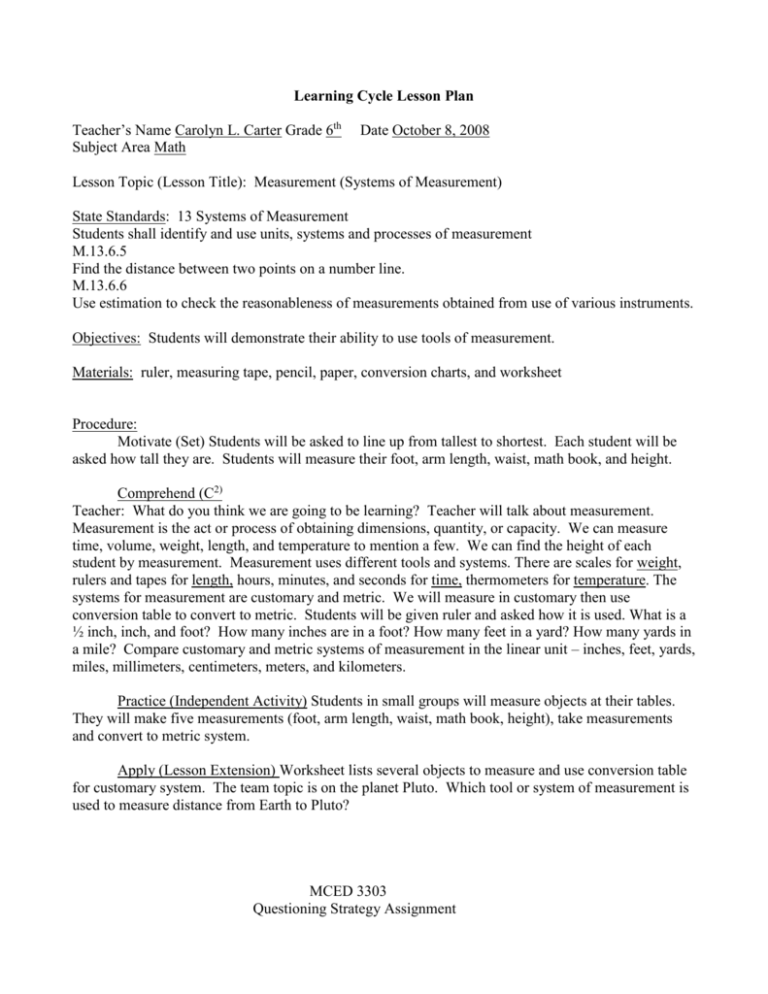
Learning Cycle Lesson Plan Teacher’s Name Carolyn L. Carter Grade 6th Subject Area Math Date October 8, 2008 Lesson Topic (Lesson Title): Measurement (Systems of Measurement) State Standards: 13 Systems of Measurement Students shall identify and use units, systems and processes of measurement M.13.6.5 Find the distance between two points on a number line. M.13.6.6 Use estimation to check the reasonableness of measurements obtained from use of various instruments. Objectives: Students will demonstrate their ability to use tools of measurement. Materials: ruler, measuring tape, pencil, paper, conversion charts, and worksheet Procedure: Motivate (Set) Students will be asked to line up from tallest to shortest. Each student will be asked how tall they are. Students will measure their foot, arm length, waist, math book, and height. Comprehend (C2) Teacher: What do you think we are going to be learning? Teacher will talk about measurement. Measurement is the act or process of obtaining dimensions, quantity, or capacity. We can measure time, volume, weight, length, and temperature to mention a few. We can find the height of each student by measurement. Measurement uses different tools and systems. There are scales for weight, rulers and tapes for length, hours, minutes, and seconds for time, thermometers for temperature. The systems for measurement are customary and metric. We will measure in customary then use conversion table to convert to metric. Students will be given ruler and asked how it is used. What is a ½ inch, inch, and foot? How many inches are in a foot? How many feet in a yard? How many yards in a mile? Compare customary and metric systems of measurement in the linear unit – inches, feet, yards, miles, millimeters, centimeters, meters, and kilometers. Practice (Independent Activity) Students in small groups will measure objects at their tables. They will make five measurements (foot, arm length, waist, math book, height), take measurements and convert to metric system. Apply (Lesson Extension) Worksheet lists several objects to measure and use conversion table for customary system. The team topic is on the planet Pluto. Which tool or system of measurement is used to measure distance from Earth to Pluto? MCED 3303 Questioning Strategy Assignment 1. Topic of lesson is tools of measurement. a. To find out what is not known or find out whether someone knows To motivate To provide drill and practice To interpret meaning b. Convergent questions have one correct answer and require reasoning. Divergent questions have several answers and help to promote possibility thinking and creativity. 2. a. I will ask questions of the Evaluate Level. Students will use knowledge to compare use of tools and systems of measurement. b. I will assess prior knowledge, motivate to attain new knowledge, apply knowledge with examples of problems, evaluate through comparison. 3. Blooms Level Convergent or Divergent Questions Knowledge C 1 Ask students how tall they are? Comprehension D 2 Explain what is measurement? Comprehension D 3 Classify objects to be measured? Comprehension D 4 Can students describe tools of measurement? Application C 5 How many inches can students predict are in 4yards? Application C 6 Can students identify which tool is best used to measure for a cake? Analyze C 7 What is best way to simply 9ft 15in.? Analyze C 8 To build a snowman which temperature is best 32 degrees Farenheight or 32 degrees Celsius? Synthesis D 9 Which profession incorporates measurement into their skill? Evaluate D 10 Which system or tools of measurement will students predict for use in measuring distance from Earth to Pluto? Conversions from metric to standard measurements SYMBOL WHEN YOU KNOW MULTIPLY BY TO FIND SYMBOL LENGTH in inches 25.4 millimeters mm ft feet 0.305 meters m yd yards 0.914 meters m mi miles 1.61 kilometers km AREA in square inches 645.2 square millimeters mm2 ft2 square feet 0.093 square meters m2 yd2 square yard 0.836 square meters m2 ac acres 0.405 hectares ha square miles 2.59 square kilometers km2 2 mi 2 VOLUME fl oz fluid ounces 29.57 milliliters mL gal gallons 3.785 liters L cubic feet 0.028 cubic meters m3 cubic yards 0.765 cubic meters m3 ft 3 yd3 MASS oz ounces 28.35 grams g lb pounds 0.454 kilograms kg T short tons (2000 lb) 0.907 megagrams (or "metric Mg (or "t") ton") TEMPERATURE o F Fahrenheit (F-32) x 5 / 9 or (F-32) / 1.8 Celsius o C APPROXIMATE CONVERSIONS FROM SI / METRIC UNITS TO STANDARD / US CUSTOMARY UNITS SYMBOL WHEN YOU KNOW MULTIPLY BY LENGTH 0.039 TO FIND SYMBOL inches in mm millimeters m meters 3.28 feet ft m meters 1.09 yards yd km kilometers 0.621 miles mi mm2 millimeters AREA 0.0016 square inches in2 m2 square meters 10.764 square feet ft2 m2 square meters 1.195 square yards yd2 ha hectares 2.47 acres ac km2 square kilometers 0.386 square miles mi2 VOLUME 0.034 fluid ounces fl oz mL milliliters L liters 0.264 gallons gal m3 cubic meters 35.314 cubic feet ft3 m3 cubic meters 1.307 cubic yards yd3 MASS g grams 0.035 ounces oz kg kilograms 2.202 pounds lb Mg (or "t") megagrams (or "metric ton") 1.103 short tons (2000 lb) T TEMPERATURE oC Celsius 1.8C + 32 Fahrenheit o F Object to Measure Foot Arm Length Waist Math Book Height Customary Metric LESSON PLAN 1. Descriptive Data Teacher: Carolyn L. Carter Subject Area: Mathematics Date November 4, 2008 Grade Level: 6th Unit Title: Pluto, Planet or Not Lesson Title: Which Measurement is Right? Lesson Number 2 Unit Concept: Pluto Lesson Topic or Overview: Measurement tools and units will equip user to select appropriate choice for situation. 2. Standards, Goals, and Objectives Standards (list local, state, or national standards which will be met upon completion of this lesson): 12: Physical Attributes M.12.6.2: Make conversions within the same measurement system in real world problems; hours to minutes, meters to centimeters, feet to inches, liters to milliliters, quarts to gallons. Lesson Goal(s): Students shall use attributes and tools of measurement to describe and compare mathematical and realworld objects. Lesson Objective(s): Compare such attributes as length, area, weight, volume, size of an angle, and select the appropriate type of unit for measuring each attribute. 3. Connections Curriculum (identify which interdisciplinary subject areas relate to this lesson): Science How does this lesson relate to previous learning and future learning of students? It will broaden the concept of measurement toward superior systems and tools used to enhance knowledge. 4. Procedure Grouping for the lesson: X whole group X small group X individual (5 minutes) Set (List specific statements or activities you will use to focus students on the lesson for the day.): -After students are seated, divide into groups of four. Assign duties of recorder, calculate and check, reporter, material handler. (5 minutes) Making the Content Comprehensible (C2 ): -Ask the following questions: How long is this pencil? How many cups does it take to fill this jar? How heavy is this rock? Is the weight of this rock more or less than 10 grams? (15 minutes) Guided Activity (GA): Come on Down! Which Measurement is Right? Each group will be presented with an object and asked a question about the size of object and its higher/lower unit of measurement. They will proceed by selecting a tool and completing the measurement to determine the actual size of item. -Ask the following questions: Which unit is identified with this object? Which tool is best used to measure object? (5 minutes) Independent Activity (IA): Each student will fill in chart of items measured listing units and tools. (5 minutes) Closure: On index card write a unit and tool of measurement learned today. Write one profession that uses measurement unit and tools daily. Write name and place card on teacher’s desk. 5. Lesson extension: The system and tools of measurement can be used in real world activities. Students in groups will apply this knowledge in creating a gallon man using strips of paper in different lengths and sizes. A gallon man is made of one gallon, 4 quarts, 8 pints, 16 cups. 6. Modifications for special needs and gifted: SN- Student will use measurement of inches only and customary system. They will be required to complete only half of problems on worksheet. GT: Student will be given measurements to convert from customary system to metric system. Worksheet will be completed and short essay written on the history of measurement. 7. Materials and Equipment needed: Items to estimate length, volume, weight, area, time. Tape measure, tools to measure items, stop watch, construction paper of various lengths, and glue. 8. Assessment of Student Learning: Students share, listen, learn from problem-solving strategies of peers. 9. Reflection and Revision Reflective thoughts about lesson: Revisions of the lesson: Item to Measure Unit of Measurement Tool of Measurement Worksheet = Liquid Measurements Directions: Fill in the blanks in the following questions. 1. 6 pints = _____ quarts 11. 2 cups = _____ pints 2. 8 cups = _____ quarts 12. 2 pints = _____ quarts 3. 8 quarts = _____ gallons 13. 4 quarts = _____ gallons 4. 16 pints = _____ gallons 14. 4 pints = _____ quarts 5. 6 cups = _____ pints 15. 8 quarts = _____ gallons 6. 1 cup = _____ pints 16. 8 pints = _____ quarts 7. 1 pint = _____ quarts 17. 12 quarts = _____ gallons 8. 2 quarts = _____ gallons 18. 12 pints = ______quarts 9. 1 gallon = _____ cups 19. 8 cups = _____ pints 20. 3 cups = _____ pints 10. 1 quart = _____ cups LESSON PLAN 1. Descriptive Data Teacher: Carolyn L. Carter Subject Area: Mathematics Date: November 17, 2008 Grade Level: 6 Unit Title: Pluto, Planet or Not Lesson Title: How much is a gallon? Lesson Number: 3 Unit Concept: _Pluto Lesson Topic or Overview: The lesser price in a smaller unit is not always a bargain. Standards, Goals, and Objectives Standards (list local, state, or national standards which will be met upon completion of this lesson): 12: Physical Attributes M.12.7.2: Understand relationships among units within the same system. M.12.8.2: Describe and apply equivalent measures using a variety of units within the same system of measurement. Lesson Goal(s): Students shall use attributes and tools of measurement to describe and compare mathematical and real-world objects. Lesson Objective(s): Students create charts comparing the cost of a gallon of gasoline to gallons of other liquids – mouthwash, juice, glass cleaner, and soda. 3. Connections Curriculum (identify which interdisciplinary subject areas relate to this lesson): Science How does this lesson relate to previous learning and future learning of students? Use measurement units and tools to determine best quantity for cost. 4. Procedure Grouping for the lesson: X whole group X small group X individual (5 minutes) Set (List specific statements or activities you will use to focus students on the lesson for the day.): Students will have groups of four. There are roles for each student – recorder, material handler, reader, calculate and check. List the cost of a gallon of gasoline. Calculate the costs of gallons of a variety of liquids. Create charts showing data collected. Use online tool to create graph comparing cost of gasoline to other liquids. (5 minutes) Making the Content Comprehensible (C2 ): Have students consider that gasoline might be a bargain when compared with the price of other liquids they consume. A bottle of water costing $1.09 works out to $8.72 a gallon. That makes gasoline look like a real bargain. (40 minutes) Guided Activity (GA): Students will have set time to complete lesson, they will depend on each other to do assigned tasks and achieve goal. Students in groups will pour a gallon of water into quarts, pints, and cups to understand relationships among units. Use Gallon Man picture to assist. Complete Gallons, Cups, and Pints worksheet. Provide students with newspaper ads from food, drug, auto parts, and home supply stores so they can price a gallon of a variety of liquids, such as soda, paint, mouthwash, oil, perfume, glass cleaner. Have students make chart with four columns: Liquid Product, Cost of Item, Size (Volume) of Item, Price per Unit/Gallon Have students calculate unit cost to gallon cost. Have student’s complete worksheet: You think gas is expensive? (5 minutes) Independent Activity (IA): Complete worksheet: How much does it cost to go to Pluto? (5 minutes) Closure: Students should share the information they collected and discuss the cost of a gallon of gasoline relative to the cost of some other things they may purchase. Lesson extension: Students can use the data they collected to create graphs providing a visual representation of data. Modifications for special needs and gifted: SN: Students use fewer items to calculate unit to gallon. Work half problems on worksheet. Work close with peers. GT: Students will calculate items to several gallons per unit of liquids. Will complete worksheet and convert to metric system. Materials and Equipment needed: Newspaper ads, calculator, and paper for graphs, pencil or marker, worksheets, Each group will have 1 gallon of water, either/or 4 quart containers, 8- 16oz. cups for pints, and 16- 8oz. cups Assessment of Student Learning: Grade students’ chart calculations on mathematical accuracy. Reflection and Revision Reflective thoughts about lesson: Revisions of the lesson: Cooperative Learning Lesson Plan Teacher’s Name Carolyn L. Carter Grade Sixth Date November 17, 2008 Subject Area Mathematics Type of cooperation (Check one): ___X__ Sink or Swim, _____Competition, ______Individualistic Select two of the elements of cooperative learning that apply the most (Check two): _____Positive interdependence, _____Face to face promotive interaction, _____Individual accountability, ___X__Interpersonal and small group skills, ___X__Group processing Type of cooperative learning groups used: Outcomes desired and/or cooperative learning objectives Learners will: Create charts comparing the cost of a gallon of gasoline to gallons of other Liquids – mouthwash, paint, fruit juice, soda, milk. Cooperative Learning Lesson Plan and Procedure Students will have groups of four. There are roles for each student – recorder, material handler, reader, and calculate and check. Students will have set time to complete lesson, they will depend on each other to do assigned tasks to achieve goal. They will communicate, use decision making to further working relationships. Teacher will monitor and provide feedback on how well groups work together. Grade student’s chart calculations on mathematical accuracy. Lesson procedure – Have students consider that gasoline might be a bargain when compared with the price of other liquids they consume. A bottle of water costing $1.09 works out to $8.72 a gallon. That makes gasoline look like a real bargain! Students will look at newspaper ads from food, drug, or home supplies so they can price a variety of liquids, such as fruit juice, soda, paint, mouthwash and gasoline. Create charts with four columns: Liquid Product, Cost of Item, Size (Volume) of Item, Price per Gallon. Record cost of gasoline then other liquids. Students will use the cost of each of the other products on the chart to calculate the cost for a gallon of the product. Groups will discuss and compare data. Materials: Newspaper ads, calculator, paper for graphs, pencils or markers, worksheets, conversion charts. You Think a Gallon of Gas Is Expensive? Just look at a few of these items you probably use. Using the cost given, compute the cost per gallon. Now is a gallon of gas expensive? Common Price Price Per Gallon $2.00 Regular gasoline, $2.00 for one gallon Diet Snapple®, $1.29 for 16 ounces Lipton® Iced Tea, $1.19 for 16 ounces Gatorade®, $1.59 for 20 ounces Ocean Spray®, $1.25 for 16 ounces Milk, $3.19 per gallon Brake fluid, $3.15 for 12 ounces Vick's Nyquil®, $8.35 for 6 ounces Scope® Mouthwash, $0.99 for 1.5 ounces White-Out, $1.39 for 7 ounces Evian® water. $1.49 for 9 ounces Coke® at movie, $3.00 for 20 ounces What item was most expensive per gallon? Did that surprise you? What items could you add to the list? Which is the most expensive when you figure price per gallon? Homework Sheet How much does it cost to go to Pluto? How much does a gallon of gasoline cost today? ______________ How many miles per gallon does a car get? ______________ How many miles per gallon does a large SUV get? ______________ How many miles per gallon does a rocket get? ______________ What is the fuel cost per mile to drive ______________? Car ______________ Large SUV ______________ Rocket ______________ How many miles is Earth from Pluto? ______2.1 Billion How much does it cost to launch a shuttle? ______________
